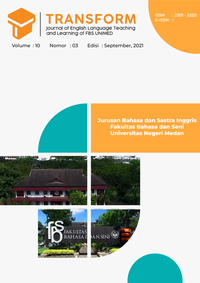The Study of Conversational Style and Preference Structure in Deddy Corbuzier™s Podcast: Anies Baswedan Episode
DOI:
https://doi.org/10.24114/tj.v10i3.44109Keywords:
Pragmatics, Conversational Style, Preference Structure, YouTube podcastAbstract
This study discussed about conversational style and preference structure in Deddy Corbuzier™s Podcast: Anies Baswedan Episode. The objectives of the study were to find the conversational style used by Deddy Corbuzier and Anies Baswedan in the podcast, the preference structure used by Anies Baswedan as the second speaker, and the dominant types of preference structure used in the podcast. This study used the descriptive qualitative method. This study used the theories from Tannen (2005) about conversational style and Levinson (1983) about preference structure. The results of this study can be concluded as: First, the conversational style used by the speakers was high-involvement style (personal topic, faster rate of speech, tell more stories, and used higher pitch). Second, the types of preference structure used by Anies Baswedan as the second speaker was preferred responses or positives responses (expected answer, agreement for assessment, and agreement for proposal). Third, the dominant types of preference structure occurred in the podcast was preferred responses because Anies Baswedan didn™t use longer pauses and delay, used faster turn-taking, gives more stories, active speaker, and produces expected answer. In a talk show, a host must be dominant in expressing ideas, opinions, or questions to the guest star. So, the speaker can freely express their thoughts and answer any questions asked by the host properly. The conversational style of an active, precise, and interesting host will also produce good responses from the guest star.Downloads
Published
2023-03-14
Issue
Section
Articles
License
Copyright (c) 2023 Desi Amalia, Juli Rachmadhani Hasibuan, Lidiman Sahat Martua Sinaga

This work is licensed under a Creative Commons Attribution-ShareAlike 4.0 International License.
Authors who publish with this journal agree with the following terms:
- Authors retain copyright and grant the journal right of first publication with the work simultaneously licensed under a Creative Commons Attribution License that allows others to share the work with an acknowledgment of the work's authorship and initial publication in this journal.
- Authors are able to enter into separate, additional contractual arrangements for the non-exclusive distribution of the journal's published version of the work (e.g., post it to an institutional repository or publish it in a book), with an acknowledgment of its initial publication in this journal.
- Authors are permitted and encouraged to post their work online (e.g., in institutional repositories or on their website) prior to and during the submission process, as it can lead to productive exchanges, as well as earlier and greater citation of published work (See The Effect of Open Access).
- This work is licensed under a Creative Commons Attribution-ShareAlike 4.0 International License.

This work is licensed under a Creative Commons Attribution-NonCommercial-ShareAlike 4.0 International License.



